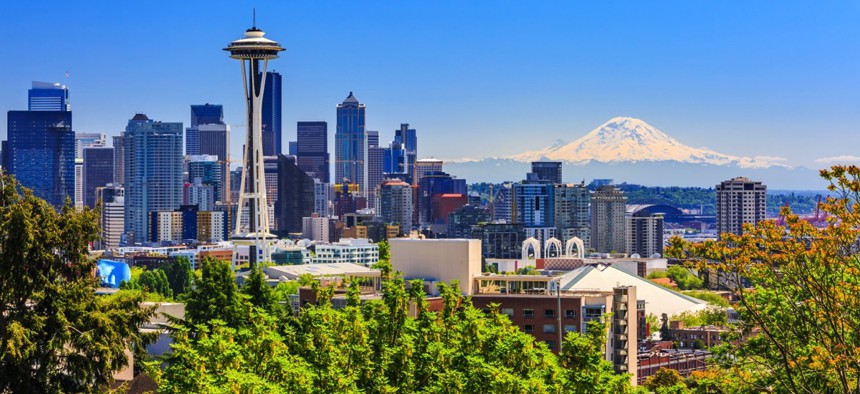Forget Smart Cities. It’s Regions That Need to Be Smarter.

Seattle
Widespread digital access and comprehensive infrastructure inventories will be the keys to regional success, according to Brookings policy experts.
WASHINGTON — A region can’t be said to be “smart” without widespread resident access to its technologies, according to policy experts Monday at a Brookings Institution event in D.C.
Only 69.4 million acres of land are urbanized across nine states, and only a third of the population lives in urban counties—making the U.S. a “country of suburbs,” said Adie Tomer, a fellow in Brookings’ Metropolitan Policy Program.
As digital telecommunications, transportation, water and energy infrastructure extend out to suburbs the lack of built-in maintenance programs becomes more noticeable and asset management more of a challenge for governments, Tomer said.
For example, locating underground water piping is a guessing game. Smart tech like “water pipe Roombas” are needed to map pipe systems, Tomer said.
The digital divide also persists with 70 million people living in neighborhoods where wireline internet subscription rates are below 40 percent, Tomer said. This is particularly a problem for 18 million school-age children who still need broadband for homework. Because parking apps require smartphones, they’re useless to one out of three houses lacking the devices.
“If we want to really tap into the digital potential of our cities and suburbs, or our smart regions, then we need to make sure everyone is digitally connected and we understand exactly where our roads are, where our pipes are, and what the quality of them is,” Tomer said.
Next-generation networks like fifth-generation wireless, or 5G, have the potential to afford access like never before, if the practice of digital redlining—not extending service to low-income or hard-to-access areas—is stopped, said Nicole Turner Lee, a fellow at Brookings’ Center for Technology Innovation.
Apps themselves can be exclusive, Turner Lee said. Allegheny County, Pennsylvania released an app to help staff identify children experiencing non-physical abuse but, upon review, found the technology was biased in that children of color were placed in foster care more often.
With smartphone use increasing, it’s up to public officials to ensure equitable deployment by creating spaces in libraries, churches or schools for those who still lack access, Turner Lee said.
“The unfortunate thing is the train has already left the station,” Turner Lee said. “The end-line economy is slowly dwindling, and we’re going to be in a race to get everybody there because of the efficiencies they afford cities.”
Preparing workers—and youth in particular—for smart technology and artificial intelligence is key, Tomer said, because 9.5 million workers will be affected by the smart city movement.
For instance, algorithms are increasingly employed by cities to extract findings from their data, but workers still need to understand how to feed those models information and what questions to ask the models.
“Knowing how to speak a language doesn’t mean you can write a good sentence,” Tomer said. “But you have the tools to do it.”
Government must become more nimble in this environment, and buck the Reaganesque notion that regulations are the problem, because new technologies like autonomous vehicles will not flourish without regulating them on the roads, Tomer said.
Tomer envisions a Federal Reserve-like body that polices data in an age when people part with it willingly, making it easy for them to be found by anyone for the right price.
“We want the network to find us when we want it, but we kind of don’t want anyone else to know where we are at the same time,” Tomer said. “But someone’s got to track that, so there’s an inherent conflict there.”
Only ten months removed from a Senate hearing where lawmakers didn’t know how to question Facebook CEO Mark Zuckerberg, Washington has become “hyperreactive” to data privacy and security issues, Tomer said.
Decentralized systems will soon automate everything with consequences on people’s employment, income and where they live, Turner Lee said, so there will need to be some mechanism for the federal government to solicit citizen feedback on data-related issues.
Government will need to ensure transparency of algorithms themselves, said Lorie Wigle, vice president of the Software and Services Group.
Cities introducing smart technology like sensors around town also open up new lines of attack for hackers, Wigle said, but there are vulnerabilities in artificial intelligence models as well.
“If the models can be reverse engineered, they can be tricked,” Wigle said.
Designing end-to-end security into disruptive tech like autonomous vehicles will be critical as a result, she added.
As the U.S. races to beat China in deploying widespread 5G—thereby dictating the market and subsequent tech applications—there is growing concern China’s regulatory structure is better for sweeping implementations.
But cities like Sacramento, California have been successful at identifying granular processes that can be automated while simultaneously educating the public about them, Turner Lee said, leading to deployment of more “responsible systems” at the local level.
Tomer pointed out that Germany completed the Autobahn before then-President Dwight Eisenhower began calling for the Interstate Highway System. While China has seen net gains in areas like fintech, or financial technology systems, that doesn’t mean everything, Tomer said.
“The truly federalist deployment of technology in the U.S. is a feature, not a bug,” Tomer said.
Dave Nyczepir is a News Editor at Route Fifty and is based in Washington, D.C.
NEXT STORY: FDA explores blockchain to secure drug supply chain






